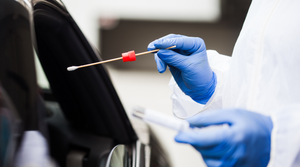PFAS: Medtech Restrictions and Impacts
For medical device manufacturers that use PTFE or PFAS-containing chemicals in their processes, additional justification, including superiority to alternatives, may soon be a necessity.
June 21, 2023

Helin Räägel, PhD, Nelson Labs
Per- and polyfluoroalkyl substances (PFAS) are a large, complex group of synthetic chemicals that have been used in consumer products around the world since about the 1950s.1 PFAS are widely used, for example, on food packaging or cookware to produce a highly non-stick surface coating. We all have enjoyed making pancakes or eggs for breakfast that do not lose their aesthetic appearance due to their unwillingness to detach from the surface of the pan when needed. The inner surface of many microwave popcorn bags is also coated with PFAS to hinder sticking.2 Similarly, many medical devices are coated with PTFE comprised of PFAS to make the surface of the device more hydrophobic and prevent adherence of cells, fluids, or blood components to the device.
The PFAS family consists of thousands of known and developed compounds, but in general they all include a carbon chain of varying length, studded with fluorine atoms. This chemical structure makes them inherently inert substances, as the bond between carbon and fluorine is so strong it is not easily degradable and therefore can bioaccumulate.
Exposure to PFAS can occur in many ways. Daily use of PFAS-coated consumer products, and the use of PFAS-containing medical devices, can lead to PFAS exposures that may bring about toxicological concern. In addition to this, due to their wide use and strong chemical bonds that make them stable over a long time, they are prone to accumulate in the environment when discarded. There, PFAS can leak into the soil, air, and ground water or accumulate in aquatic organisms. It can then be for consumed through, for instance, drinking water.
But why are we so worried about PFAS?
It has been shown that these chemicals have a relatively long half-life (ranging from 3.8 to 8.5 years),3 which means that the PFAS can bioaccumulate in the human body, and therefore begin to impact the health of the population. To understand the full extent of exposure to PFAS, in the US alone, over 95% of adolescents and adults have measurable serum levels of various PFAS chemicals.4
Over the past several years, there has been numerous publications on the potential impact of exposure to PFAS and the implications to adverse health effects, including altered metabolism, fertility, reduced fetal growth, increased risk of being overweight or obese, increased risk of some cancers, and reduced ability of the immune system to fight infections.1
In 2017, the Swedish Chemicals Agency (KEMI) and the German Environment Agency (UBA) proposed a restriction of six PFAS variants under REACH5 due to their link to a variety of health concerns, their very slow degradation profile, and bioaccumulation potential. This initiated the movement toward regulating their use and led to the final decision by the EU in February 2023 to ban, in phases, 200 PFAS. To note, although the actual ban only covers six long-chained PFAS chemicals — where the molecules consist of between 9 and 14 fluorinated carbon atoms — the number of PFAS being restricted is 200, since they can all be broken down into one of the banned six substances.5 Furthermore, in March 2023, the US Environmental Protection Agency (EPA) announced a proposed PFAS drinking water regulation where the legally enforceable Maximum Contaminant Level (MCL) for the six PFAS variants is set at 1.0 up to 4.0 parts per trillion (or 4.0 ng/L).6
What do these restrictions and proposed MCLs mean for medical devices? When devices are evaluated for their safety during use, they are tested for their biocompatibility, and oftentimes due to short contact duration a detailed chemical analysis is not performed; as risks for any chemical, including PFAS, to leach out of a device and be exposed to the patient depends on the duration of contact. Knowing that there is a specified limit to a subgroup of PFAS, it might be easy to say that we need to start regulating their exposure for medical devices as well; as the standard approach to evaluating toxicological risks is based on known, standardized limits set forth by guidance document or governmental institutions. However, for example, understanding that the allowable limit of perfluorooctanoic acid (PFOA) (one of the six PFAS under regulation) is set at 4 ng/L in drinking water, should it and, most of all, can it be applied to a medical device with PFAS coating? Moreover, if we are mostly worried about environmental impact, where do we draw the line on allowable PFAS levels for the medical devices in general?
For medical device manufacturers that do not use PTFE or other PFAS-containing chemicals in their processes, this movement may only mean an additional so-called “pen-and-paper” approach that clarifies that these substances are not used in their devices. However, if PFAS are present, additional justification for their necessity, including superiority to alternative chemicals may be on the horizon. This, along with the actual testing for the restricted PFAS substances may need to be figured out. Which sounds easier said than done, as the MCL set forth by the US EPA for drinking water seems so low that reaching those analytical thresholds for medical devices may prove to be potentially impossible.
References:
1. https://www.niehs.nih.gov/health/topics/agents/pfc/index.cfm
2. https://ipen.org/documents/toxic-hazards-microwave-popcorn
3. Olsen GW, Burris JM, Ehresman DJ, Froehlich JW, Seacat AM, Butenhoff JL, Zobel LR. Half-life of serum elimination of perfluorooctanesulfonate, perfluorohexanesulfonate, and perfluorooctanoate in retired fluorochemical production workers. Environ Health Perspect. 2007 Sep;115(9):1298-305. doi: 10.1289/ehp.10009. PMID: 17805419; PMCID: PMC1964923. https://www.ncbi.nlm.nih.gov/pmc/articles/PMC1964923/
4. Kato K., Wong L.Y., Jia L.T., Kuklenyik Z., Calafat A.M. Trends in exposure to polyfluoroalkyl chemicals in the U.S. Population: 1999–2008. Environ. Sci. Technol. 2011;45:8037–8045. doi: 10.1021/es1043613
5. https://chemsec.org/proposed-restriction-of-200-pfas-intended-to-prevent-regrettable-substitution/
6. https://www.epa.gov/sdwa/and-polyfluoroalkyl-substances-pfas
7. https://echa.europa.eu/hot-topics/perfluoroalkyl-chemicals-pfas
8. https://eur-lex.europa.eu/legal-content/EN/TXT/PDF/?uri=CELEX:32019R1021&from=EN
9. https://eur-lex.europa.eu/legal-content/EN/TXT/PDF/?uri=CELEX:32020R0784&from=EN
10. https://www.ncsl.org/environment-and-natural-resources/per-and-polyfluoroalkyl-substances#
You May Also Like


